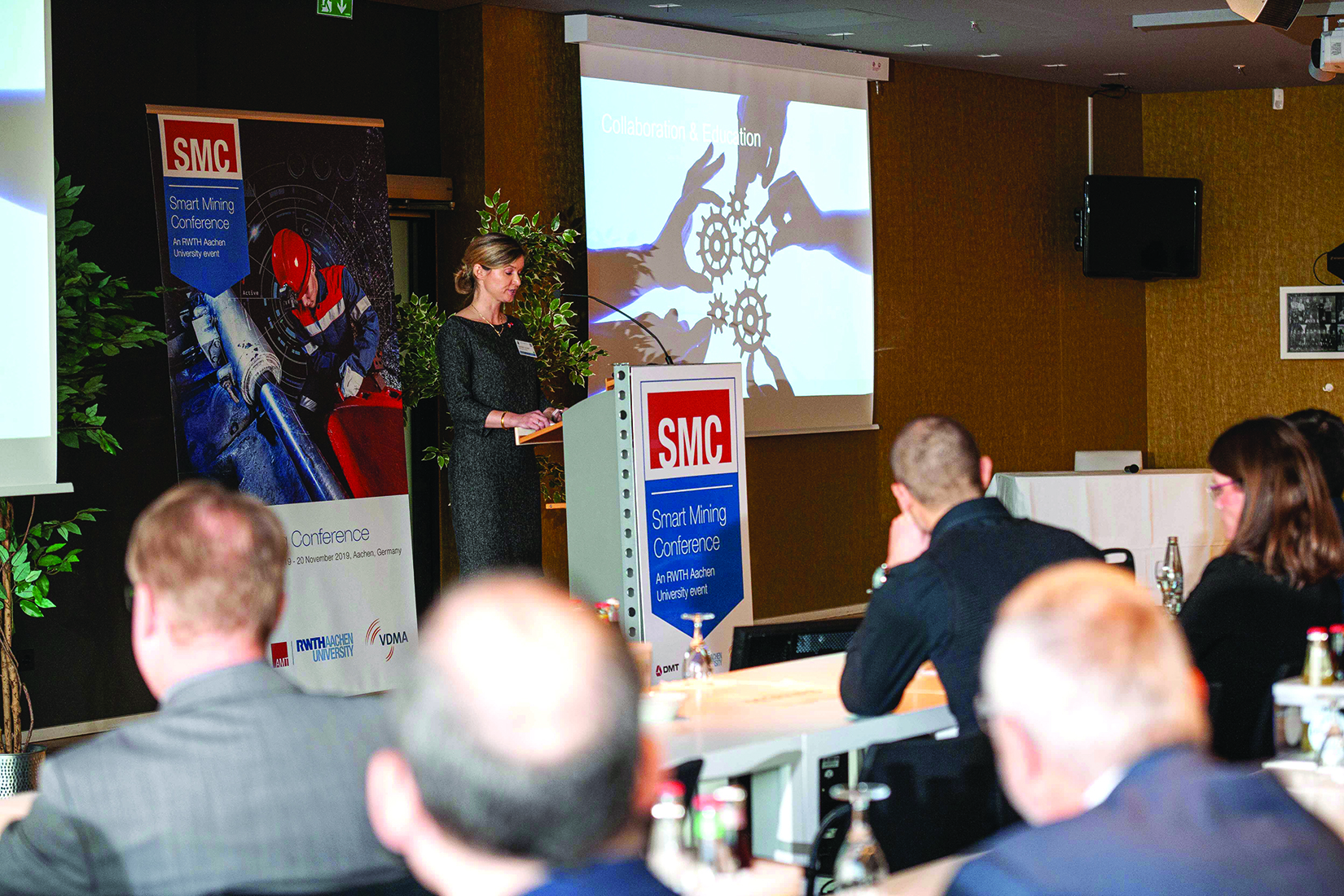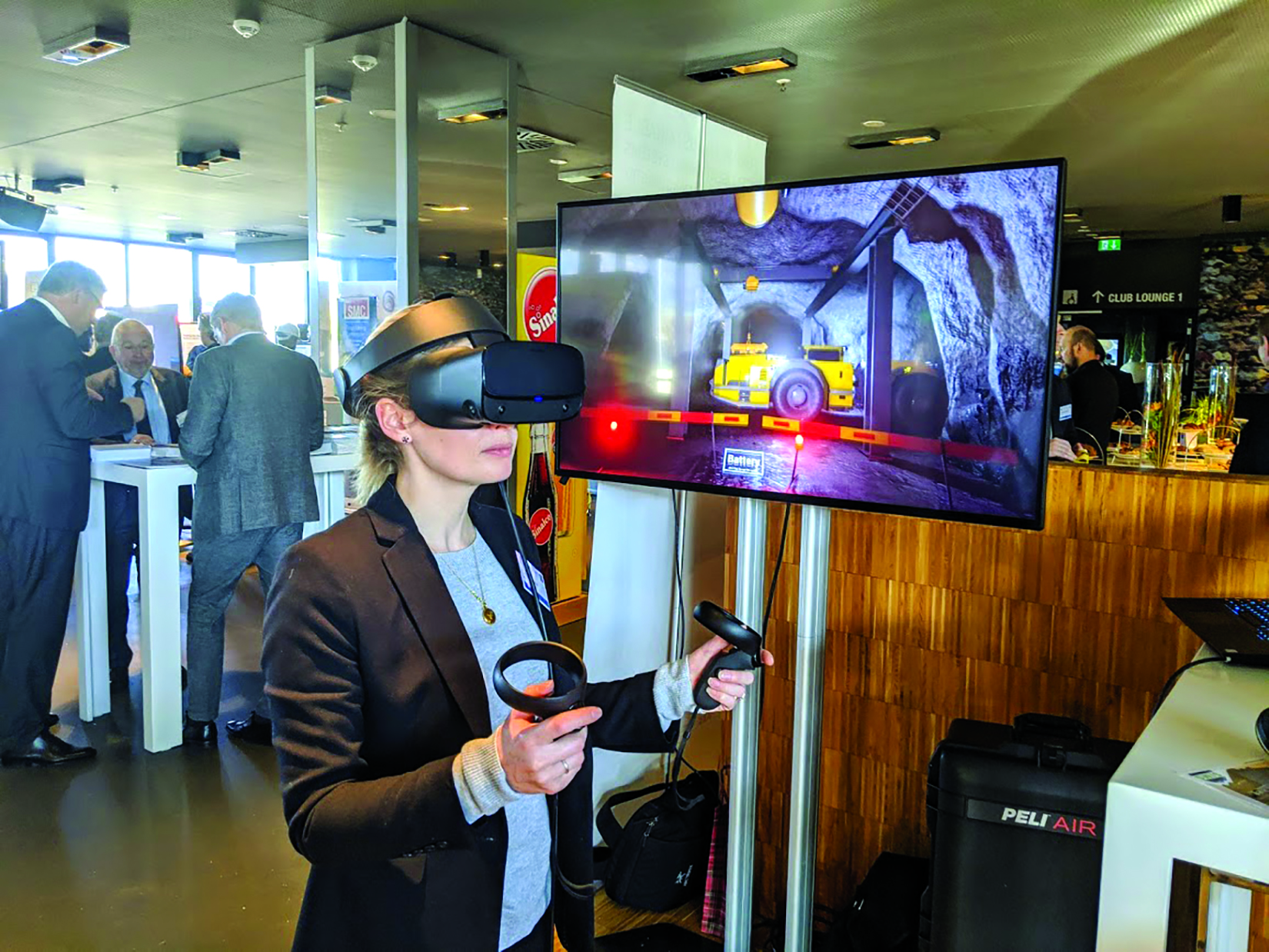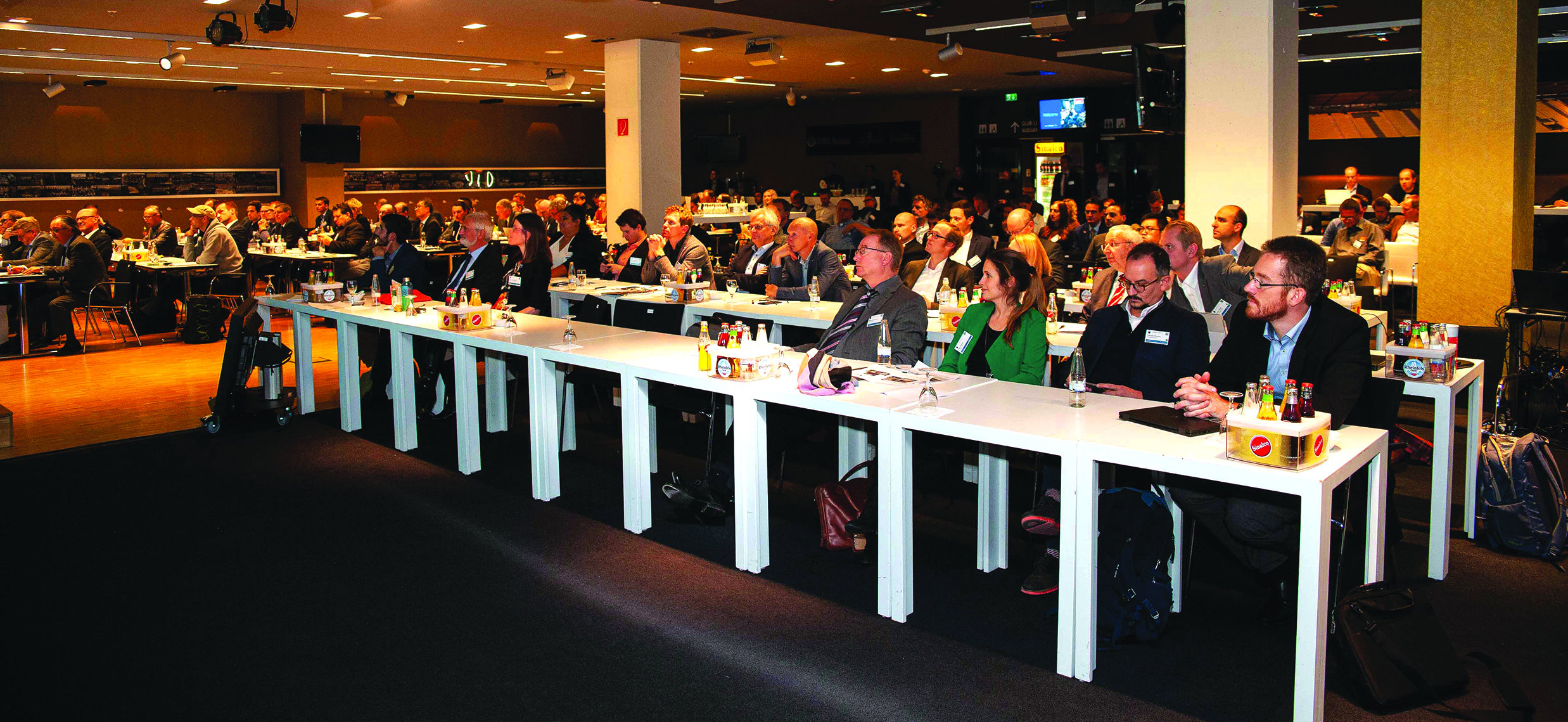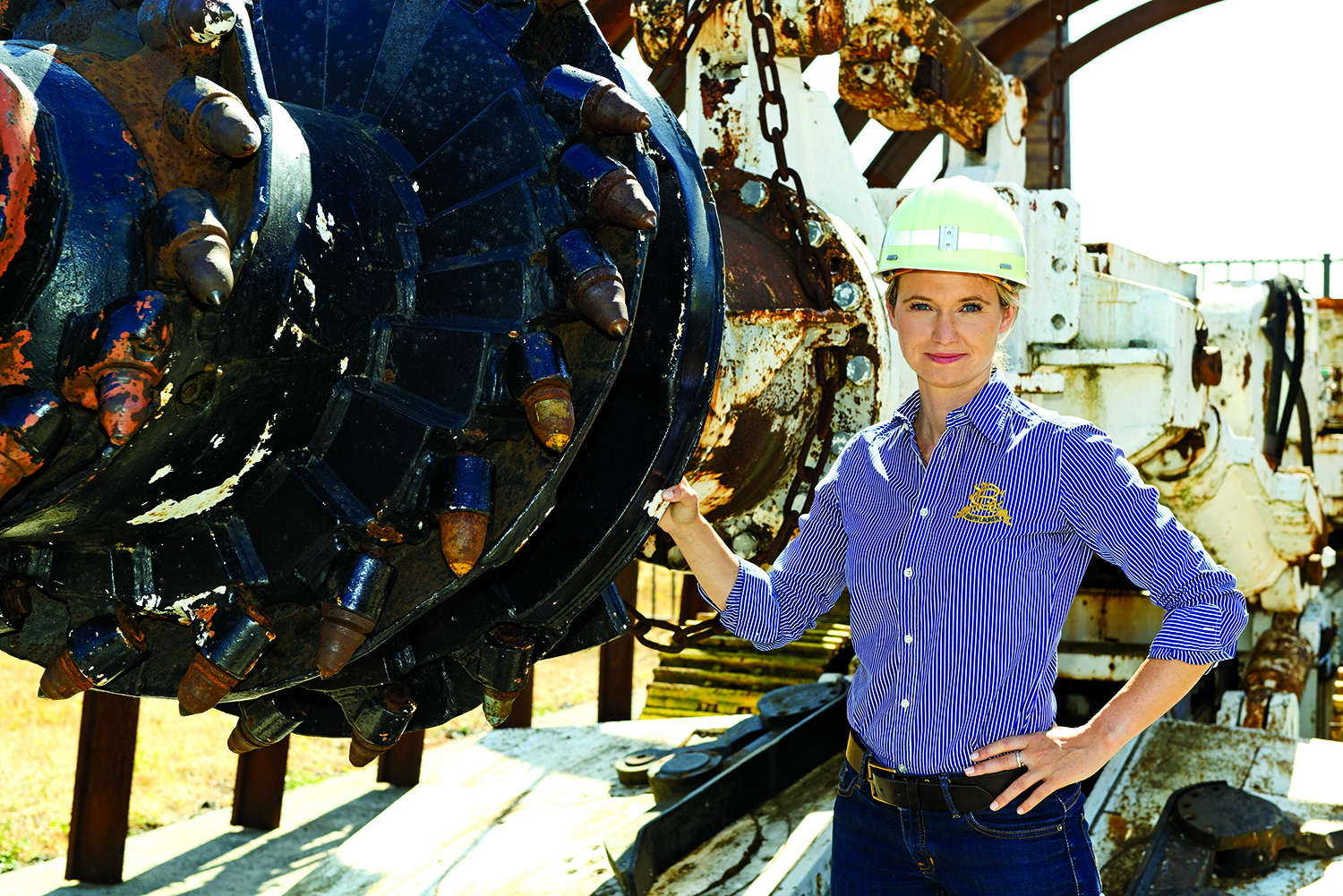
Professor Clausen delivers the welcoming address at the 2019 Smart Mining Conference in Aachen, Germany.
A Q&A session with leading German academic for mining technology sheds light on education and training initiatives
In November 2019, the Institute for Advanced Mining Technologies (AMT) at RWTH Aachen University, together with VDMA Mining and DMT GmbH & Ko KG, co-hosted their biannual Smart Mining Conference. The event was a masterclass in collaboration between industry and research. Carly Leonida caught up with Professor Elisabeth Clausen, director of the AMT, following the event to talk about its focus and the institute’s current projects.
CL: Tell us a bit about the AMT’s history and its relationship with the VDMA.
EC: The AMT, including its predecessor institutes, has always strived to contribute to enabling safer and more efficient resource extraction. Based on fundamentals in mechanics for mining machinery followed by structural health and process monitoring, in recent years, our focus has further evolved toward sensor technologies and autonomous systems as a prerequisite for advancing the automation and digitalization of machines and processes in harsh mining environments.
This continuous adaptation to changing requirements is reflective of one of our core values that has remained consistent throughout the decades, which is to combine fundamental research with a strong focus on application and partnering with industry to advance technological developments that benefit the industry but also society at large.
The relationship between VDMA Mining and the AMT is rooted in this commitment and partnership with industry and we are very happy that such a strong relationship has grown and matured over the years, resulting in various forms of collaboration, one of them being our annual that VDMA Mining and DMT GmbH & Ko KG have been co-organizing with us for several years now. The Smart Mining Conference and, respectively, the High-Performance Mining Conference, provide an annual platform to showcase, discuss and advance innovation through collaboration in the mining industry.
I really enjoyed the Smart Mining conference in November. What, for you, were the highlights?
Thank you. I am glad you enjoyed attending! There were a number of highlights, for sure, but four things really stood out for me.
Firstly, I felt that the realization that innovation is not possible without collaboration really was widely shared and sort of trickled down to everyone over the two days. Secondly, the large Canadian delegation was a definite highlight; more than 20 Canadian companies attended and that enriched the program and networking activities, and also contributed to the spirit of collaboration in a very tangible way.
Thirdly, I think there was a great overall balance of topics, addressing technology, but also the human and environmental factors, and a great diversity of participants representing the regional, national and international industry, research institutions as well as the public sector. This variety and diversity allowed the conference to become a really vivid platform that was well utilized for networking, discussion and the facilitation of collaboration, even internationally.
Lastly, the fact that we were able to also showcase the Sustainable Intelligent Mining Systems (SIMS) project as a large European flagship project really made innovation and the dynamism of change in the industry tangible during the conference.
Why are events like these so important to the German mining industry, particularly following the closure of many key coal operations over the past five years?
Despite what seems to be the general public opinion, Germany is still an important mining country, and many raw materials, especially potash and raw materials used in construction and energy production are mined in Germany at a large scale. And even though there are currently few metal mining operations in Germany, there is metal mining and other mining activity in neighboring European countries.
Rooted in Germany’s long mining tradition, we have a very strong mining supply sector that is organized in the VDMA Mining today. With an export rate of above 95%, German suppliers are among the leading technology providers for mining operations all over the world. Their success on an international scale is by no means coincidence though. Many of those companies have been around for more than 100 years and have a strong culture of internal R&D, innovation and continuous improvement.
Our annual conferences, alternating between the Smart Mining Conference and the High-Performance Mining Conference, provide an important platform for networking and dialog, but also for showcasing new developments in technology, for showing what has been done elsewhere and what solutions are on the horizon, for inspiring confidence toward innovation and transformation and thereby contributing to inspiring continuous improvement and change in the industry.
Whereas our Smart Mining Conference is focused on showing new developments in technology around automation and digitalization, this year’s High-Performance Mining Conference (November 17-18 in Aachen) will again place a strong focus on joint operator-supplier presentations to address a broader set of issues that are relevant for futureproofing the mining industry.
The High-Performance Mining Conference is meant to inspire operators and suppliers alike by showing benchmark examples of what has been achieved in various projects around the world to improve productivity but also to ensure future value creation.
I felt that the Smart Mining presentations offered a good balance between new equipment/technology and the continued importance of people. What are your thoughts on the role of people within the industry?
Yes, it is very important for us to ensure there is this balanced view, because technological transformation only succeeds if we take the people along on the journey. This balanced approach is also reflective of the values that inform our approach to education. The more digitized and automated our world becomes, the more important it becomes to nourish and create space for creativity.
I firmly believe humans will continue to play an important role in the industry, although this role will shift. With all the advances in technology and especially artificial intelligence, humans will remain superior with respect to emotional intelligence, creativity, empathy, cognitive flexibility and problem-solving skills in complex environments as far as I can see and anticipate the future. That is why we try to emphasize social competencies in our approach and methodology to education.
The AMT’s graduates are among the most sought after in the industry. How does your syllabus and approach to teaching help make its students stand out?
Our overarching objective in educating tomorrow’s mining engineers is to give them the best preparation possible to deal with and adapt to changing requirements of job profiles in the industry today. This implies making sure that they have strong disciplinary skills as a foundation, which is always important and very much necessary, but to go beyond that and also provide them with problem-solving skills and other soft skills that are just as important today as disciplinary knowledge.
At the AMT, we are aware that the competences required have changed and will continue to change and that is why we place a strong emphasis on continuous development and adaptation of our courses and programs. One example is the recent introduction of an entirely new study program within the Division of Mining Engineering, Mineral Processing and Recycling focusing on sustainable energy and raw materials supply. Another example is a stronger focus on data literacy and data competence, reflected i.e., in the introduction of a new course focused on “data analytics for heavy duty machinery.”
To sum it up, combining a solid foundation of engineering and natural sciences and disciplinary skills with modern, competence-based and practice-oriented methodologies for teaching and learning is what enables our graduates to become well-rounded and adaptive future employees.
Tell us about the Learning Factory Mining 4.0
The Learning Factory Mining 4.0 is the first of its kind and we are very proud to be able to establish such an innovative learning space on our institute premises. Again, collaboration with industry played a role in realizing this project as the Ulrich-Thiele foundation is co-funding the initial infrastructure of the physical and cyber-physical modules within the learning factory.
As a concept, the learning factory enables students to activate the knowledge they have learned and to apply it, using a broad range of sensory experiences. It fosters self-driven, active and hands-on learning and supports the development of flexible problem-solving skills, thereby optimizing learning outcomes. The IT-component is very important here as well, which is why we have placed an emphasis on cyber-physical modules complementing the physical modules.

The event also included an exhibition area where delegates could see and even try out some of the technologies described during the presentations.
In really practical terms, the learning factory will be an actual laboratory like space with different kinds of modular learning cubes that allow for practical, hands-on learning experiences. Combined with our project-based learning modules, the learning factory will contribute to even better prepare students for the real-world problems they will be confronted with on the job and to acquire the flexibility to deal with a variety of problems that require them to combine different skills and concepts.
At the same time, with the Learning Factory, we are creating a space or an environment in which (student) ideas can be further developed and thus be an incubator for student spin-offs.
Can you outline some of the other projects that the AMT is leading this year, both at home and abroad? They seem incredibly varied.
Yes, it is true that our research projects cover a broad range, not just of research areas, but also with respect to the technology readiness levels within the different projects. However, there is a structure behind what we do, of course.
For one, our research focuses on and covers the entire data information value chain, from data generation and acquisition to data processing and evaluation. Consequently, our research deals with hardware development (sensors) as well as software development (algorithms). With respect to hardware development, we focus on three distinct sensor technologies, namely infrared thermography, acoustic emission, and ultra-wide band technology. Those technologies are not new, but the way we apply them under harsh mining conditions and the way we make them work together with software to actually gain valuable information and insight from the sensors is what makes our research unique in this area.
We are actually the only institute globally that is doing research in this particular area of digitizing the mining world. These sensor technologies can be applied in various areas to provide smart services to the mine. These application areas, which constitute our main research areas, include object recognition, material identification, boundary layer detection, underground positioning and autonomous navigation as well as the automation of machines and processes. As a new research area, we have recently started applying our technologies to the deep-sea mining environment as well.
In addition, we are also engaged in international education projects to keep advancing and improving our curriculum and teaching methodology. We are active in various international networks to foster exchange on good practices and to always stay informed about new developments in this area as well.
What does the future hold for the AMT?
We believe the technologies we develop are enabling the mining sector to become more responsible and sustainable by making mining machines and processes safer, more efficient and by decreasing the environmental impact through digitalization and automation.
Without sensors and without developing ways to generate qualitative date and to extract useful information from all the data we collect, digitalization and automation is not possible. Therefore, we lay the foundation for Mining 4.0 to continue becoming a reality.
If there is one constant in all the changes that we will surely undergo in the future, it will be that we will continue to evolve technological developments, that we will continue to educate the best engineers and we will continue to transfer knowledge and technologies in order to contribute to societal progress.
Furthermore, we will contribute to shaping the future by supporting the startup of new companies in a highly dynamic environment and thus continue the successful tradition of our predecessor institutes, which has led to seven successful spin-offs in the last 25 years.












